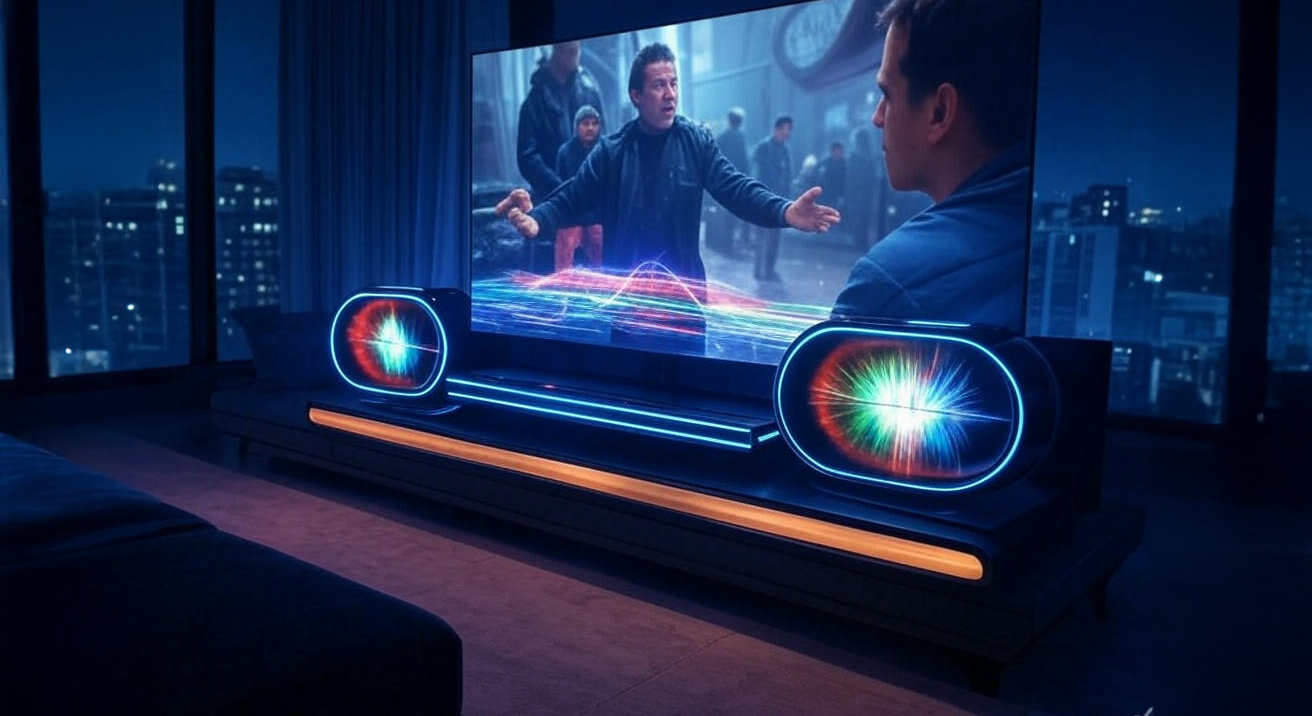Imagine it’s Friday night, and you’re prepping for a movie marathon with friends.
The TV’s glowing, snacks are out, but the sound’s weak—barely cutting through the chatter.
You spot an old soundbar under a pile of cables from your last TV upgrade, and your newer one’s already hooked up.
A spark hits: could two soundbars together turn your living room into a theater?
It’s a tempting idea, especially if you’re after epic audio without draining your wallet.
I’ve been there—a quiet action flick last month had me eyeing my spare soundbar, wondering if doubling up could save the night.
The good news is that connecting two soundbars is technically possible. The catch? It’s rarely the smooth, powerful fix you’d hope for.
Soundbars are quirky, built to dazzle solo, not harmonize with a twin. Still, if you’re game to try, there are ways to make it happen, plus pitfalls to dodge.
In this guide, we’ll walk through how to connect two soundbars, troubleshoot with expert tips, spotlight top products like the LiNKFOR TOSLINK to simplify it, and weigh smarter alternatives for the sound you crave. Let’s dive in!
Become an Acoustics Insider!
Gain access to expert insights on acoustic panels, soundproofing, soundbars, DJ controllers, MIDI setups, turntables, and more—plus exclusive tips and gear recommendations to perfect your audio world.
We value your privacy—unsubscribe anytime, no spam ever, using the link in our newsletter.
Can You Connect Two Soundbars Together?
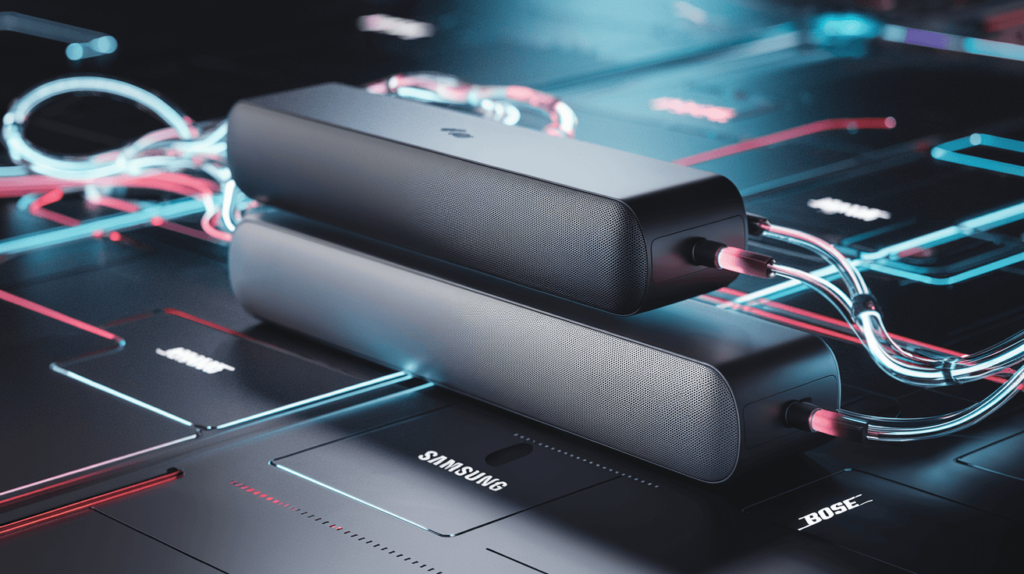
Yes, connecting two soundbars is technically possible, but it’s not as easy as plugging in earbuds. These devices are designed to shine alone, syncing with your TV, phone, or streaming box for crisp audio.
Unlike multi-room speakers that sync effortlessly, most soundbars lack the wiring or software to pair with a partner—no master-slave tech like stereo speakers use. That said, with the right tools or features, you can force it.
Manufacturers seldom plan for this, so results vary. High-end models from brands like Sonos, Samsung, Bose, LG, JBL, Yamaha, TCL, or Denon offer ways to link with other speakers in their ecosystems. A Sonos Arc, teams up with a Sub or rear speakers via their app, but two Arcs together isn’t an option.

Sonos Arc
Seamlessly integrate into an ecosystem or use as a standalone audio solution.
Check Price On AmazonSamsung’s Q-Symphony ties soundbars to compatible TVs or speakers, not another soundbar directly. Bose SimpleSync pairs with a Bose speaker, LG has multi-speaker modes, JBL offers surround kits, Yamaha’s MusicCast links units, TCL pushes budget surround, and Denon’s HEOS syncs—all within their walled gardens.
Firmware updates might unlock tricks—AVSForum users tweak custom settings for the Sonos Arc, and TCL owners report hacks—but for generic models, you’re often stuck. Why try? Let’s unpack that.
Why You Might Want to Connect Two Soundbars

The appeal of connecting two soundbars is clear. Maybe you’re hosting a movie night and want sound that punches through chatter, or your L-shaped room needs audio in every corner. Perhaps you’re dreaming of a DIY surround setup, with sound hitting you from all sides.
A friend once rigged two soundbars for a garage party, hoping to flood the space with music—it half-worked, with one blaring louder, but it fueled the idea. If you’ve got a spare soundbar from an old TV, pairing it with a newer one feels like a clever way to boost bass or widen the soundstage.
It’s a hack that promises double the hardware for double the punch—at least on paper. There’s a thrill in tinkering, too; we love outsmarting the system, chasing that “aha” moment even if it’s a stretch.
It might seem like a wallet-friendly leap without buying a fancy setup. But soundbars aren’t built for teamwork, so the dream might falter. Let’s explore how to make it happen and what’s in store.
How to Connect Two Soundbars (If Possible)
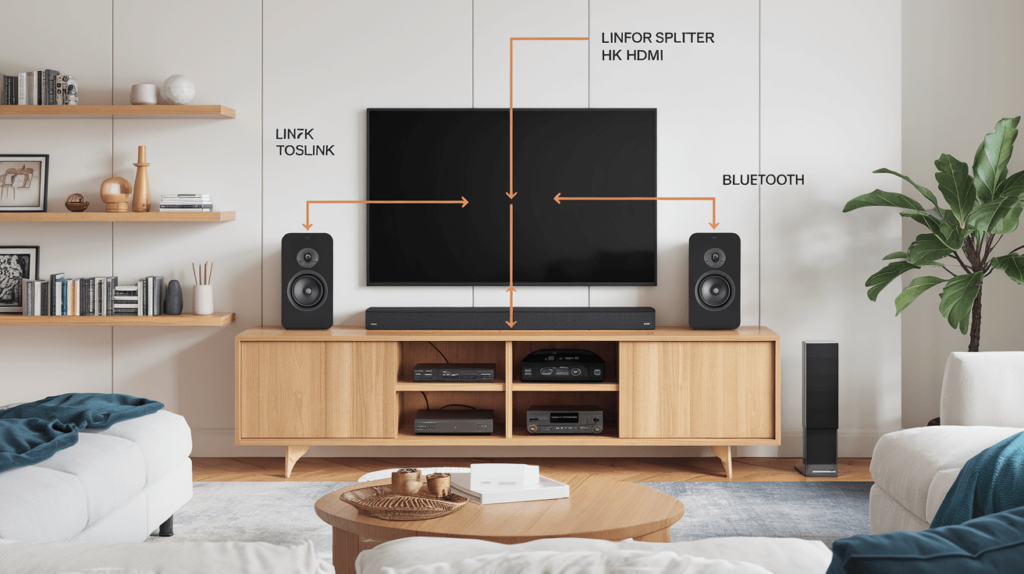
Connecting two soundbars isn’t hopeless, and there are paths to try based on your gear. One solid option is an optical splitter. If your TV and both soundbars have optical ports, pick up a LiNKFOR 1×2 TOSLINK Splitter, about $20 on Amazon.

LiNKFOR 1×2 TOSLINK Splitter
Enhance your audio setup by connecting two soundbars via optical with this reliable splitter.
Check Price On AmazonPlug your TV’s optical output into the splitter’s input, then grab two TOSLINK cables—keep them under 10 feet to avoid signal fade—and connect them from the splitter’s outputs to each soundbar’s optical in. This splits the audio, sending it to both units at once.
Test it with a movie; set your TV to PCM output in the sound menu for best results—you should hear both kick in. It’s simple and cheap, great for basic setups, though it maxes at 5.1 surround sound—no Dolby Atmos here. If one’s quiet, check cable fit; loose ends kill it.
Another route is an HDMI splitter. This costs more but has perks. Get an OREI UHD-102 HDMI Splitter, around $35 on Amazon, which supports HDMI ARC. Hook your TV’s HDMI output to the splitter’s input, then use two HDMI cables to connect each soundbar to the splitter’s outputs.

OREI UHD-102 HDMI Splitter
Connect two soundbars via HDMI ARC with this high-quality splitter for enhanced audio distribution.
Check Price On AmazonFolks have tested this with Samsung Q-series models, and it can work if ARC aligns. You might control both with one remote—enable CEC in your TV’s settings, often under “HDMI Control”—though volumes sync together. If sound stutters, confirm your TV’s HDMI port supports ARC; older sets might need an update or won’t cooperate. It’s slicker for HDMI setups, but compatibility’s key.
If cables aren’t your vibe, Bluetooth might work. A soundbar like the Vizio V-Series 2.1, about $150 on Amazon, supports Bluetooth. If your TV—like some LG OLED C-series—outputs to two Bluetooth devices, pair each soundbar one at a time.

Vizio V-Series 2.1 Soundbar
Enjoy flexible audio upgrades with Bluetooth pairing or a single-unit enhancement.
Check Price On AmazonGo to “Sound Out” in your TV’s menu, select Bluetooth, pair the Vizio, then add a second—test with music to spot lag. Few TVs manage this—my old Sony couldn’t—so check your manual. If sync’s off, tweak audio delay in advanced settings; 10–20ms might help, but Bluetooth 5.0 on the Vizio cuts lag best.
For optimal sound, position soundbars 3–6 feet apart at ear level, angled 30° toward your seat for stereo width—think of it like setting up bookshelf speakers. High-quality cables matter too; with the OREI UHD-102 HDMI Splitter, use high-speed HDMI cables to ensure ARC stability. This won’t hit Dolby Atmos, but it can widen your soundstage if sync holds.
Need pairing basics? This step-by-step guide walks you through Bluetooth setup. Warranties might squint at these hacks, so check your terms.
Each method has charm. Optical keeps it cheap, HDMI adds control, Bluetooth cuts clutter. But possibility isn’t perfection. Let’s dig into the hurdles.
Considerations When Connecting Two Soundbars

Even if you link two soundbars, the result might not harmonize. Sound balance is a biggie. Even identical models can differ—one might thump with bass, the other skew sharp on highs.
A neighbor tried this with two budget units; one blasted bass while the other screeched, drowning dialogue in a mess—he ditched it after a week.
That unevenness turns audio into a tug-of-war, not a team. It’s subtle but jarring, like clocks ticking offbeat. Want to decode why specs matter? This article explains how channels and power affect performance.
Syncing woes hit too, especially with Bluetooth. Wireless lag can offset one soundbar by a fraction, creating an echo that tanks movies. Wired setups like the LiNKFOR TOSLINK or OREI HDMI Splitter fare better, but soundbars process audio at their own pace. Some TVs—like newer Samsungs—let you tweak output delay; a 10ms nudge in sound settings might help, but it’s a patch. Without built-in sync tech, you’re chasing shadows.

LiNKFOR 1×2 TOSLINK Splitter
Enhance your audio setup by connecting two soundbars via optical with this reliable splitter.
Check Price On Amazon
OREI UHD-102 HDMI Splitter
Connect two soundbars via HDMI ARC with this high-quality splitter for enhanced audio distribution.
Check Price On AmazonDesign’s the crux. Soundbars are lone wolves, built to shine solo or with a subwoofer, not paired. Rigging two might not beat a single unit.
Cost-wise, a $50 setup with a splitter and cables sounds thrifty, but a $200 Polk Audio Signa S2 from Amazon delivers clearer sound and less hassle—my neighbor swapped his DIY mess for one and never looked back.

Polk Audio Signa S2
Upgrade your audio affordably with this cost-effective single-unit soundbar.
Check Price On AmazonTwo 100W soundbars like the Vizio V-Series 2.1 hit 200W combined, doubling raw power over a $150 unit. But mismatched EQs or latency can cut clarity—a Samsung HW-Q990D with 600W and tuned surround often wins for less fuss.

Samsung HW-Q990D
Experience immersive surround sound with this versatile alternative.
Check Price On AmazonCommon Mistakes to Avoid

Before you start, dodge these traps. Don’t use cables over 10 feet with the LiNKFOR TOSLINK—signal fades fast; stick to 6-foot runs. Mixing brands, like a Vizio with a Sony, tanks sync—stick to matching models like two Vizio V-Series 2.1 units.
Skipping your TV’s manual is a rookie move; not all support dual Bluetooth or ARC. A quick check saves headaches.
Troubleshooting Dual Soundbar Setups
No sound from one unit? For LiNKFOR TOSLINK, ensure PCM output—Dolby Digital can mute one. With OREI HDMI Splitter, check ARC settings; reset via TV menu if silent. Bluetooth lag? Adjust delay to 15ms or swap to wired—sync’s tricky.”
What to Check Before You Try
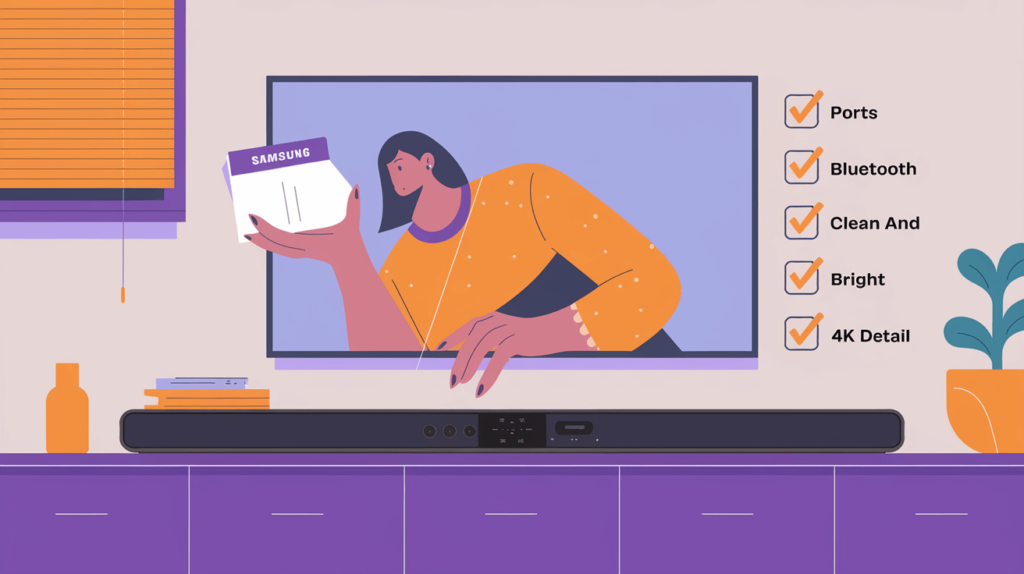
Save grief with a rundown. Confirm your soundbars’ ports—do they both have optical or HDMI ARC? Mismatched inputs sink the plan. For Bluetooth, check versions—5.0 cuts lag—and test if your TV supports dual output; most don’t.
Pairing a Vizio V-Series 2.1 with a Samsung TV might work if both cooperate—test it first. Peek at manuals or forums—users unearth hacks. Mixing brands? Odds drop, so matching helps. Unsure about TV compatibility? This guide details smart TV setup steps.
Alternatives to Connecting Two Soundbars

If pairing soundbars feels shaky, there’s a cleaner path. Try a surround-ready system like the Samsung HW-Q990D, around $500 on Amazon. It bundles rear speakers and a sub, trouncing two $150 soundbars in clarity—no sync woes, just immersion.

Samsung HW-Q990D
Experience immersive surround sound with this versatile alternative.
Check Price On AmazonWant to add rear speakers? This ultimate guide walks you through it. Multi-room setups shine too—grab a Sonos Beam Gen 2, about $450 on Amazon. It syncs via app, outpacing two soundbars, and works with multiple devices—check this out for more.
Some stores let you rent Sonos to test. Or go premium: the Bose Smart Ultra Soundbar, around $900 on Amazon, or Sony HT-A8000, near $1,000, pack Dolby Atmos and outshine DIY pairs—worth it if budget allows.

Bose Smart Ultra Soundbar
Elevate your audio with this premium Atmos alternative for superior sound quality.
Check Price On AmazonRecommended Audio Gear for Your Soundbar Setup
| Image | Product | Purpose | Check Price |
|---|---|---|---|
| Connection Tools | |||
 |
LiNKFOR 1×2 TOSLINK Splitter | Connect two soundbars via optical | Check Price |
 |
OREI UHD-102 HDMI Splitter | Connect two soundbars via HDMI ARC | Check Price |
| Soundbars | |||
 |
Vizio V-Series 2.1 Soundbar | Bluetooth pairing or single upgrade | Check Price |
 |
Polk Audio Signa S2 | Cost-effective single-unit upgrade | Check Price |
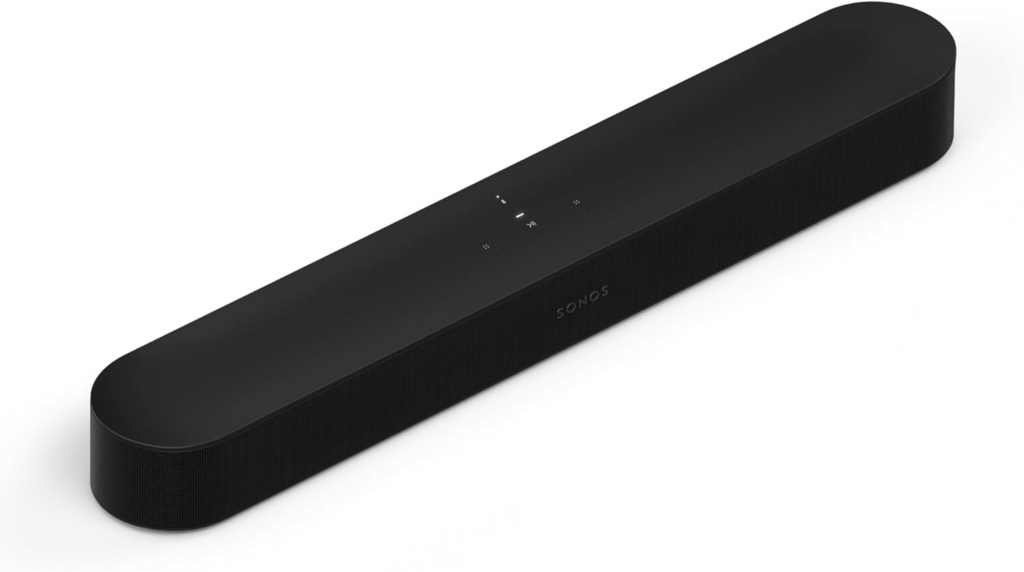 |
Sonos Beam Gen 2 | Multi-room audio alternative | Check Price |
 |
Samsung HW-Q990D | Surround sound alternative | Check Price |
 |
Sonos Arc | Ecosystem pairing or standalone | Check Price |
 |
Bose Smart Ultra Soundbar | Premium Atmos alternative | Check Price |
Conclusion
So, can you connect two soundbars together? Technically, yes—a LiNKFOR TOSLINK, OREI HDMI Splitter, or Bluetooth can do it if your gear aligns. But it’s bumpy. Sound balance wavers, syncing nags, and the payoff might not top a smart pick. A buddy tried this—two cheap soundbars echoing like bad karaoke. He swapped them for a Samsung HW-Q990D and grinned ear to ear.
Soundbars thrive alone or with partners, not as twins. For impact, grab a surround system or multi-room setup. Tried this? Got a favorite soundbar or hack? Spill it in the comments—we’re all ears!
FAQs
Mixing brands? Rarely works—sync crashes. Void warranties? Maybe, if you push hard; check terms. Cheapest fix? A $20 LiNKFOR TOSLINK beats a $200 Polk Signa S2 for cost, not punch.
